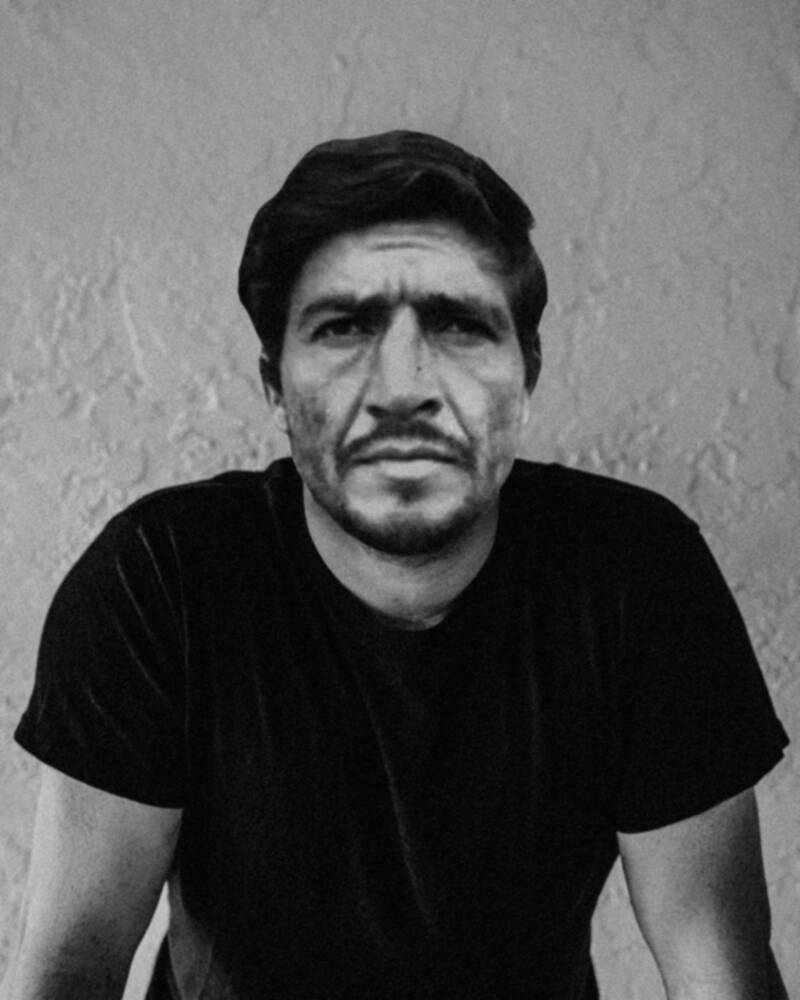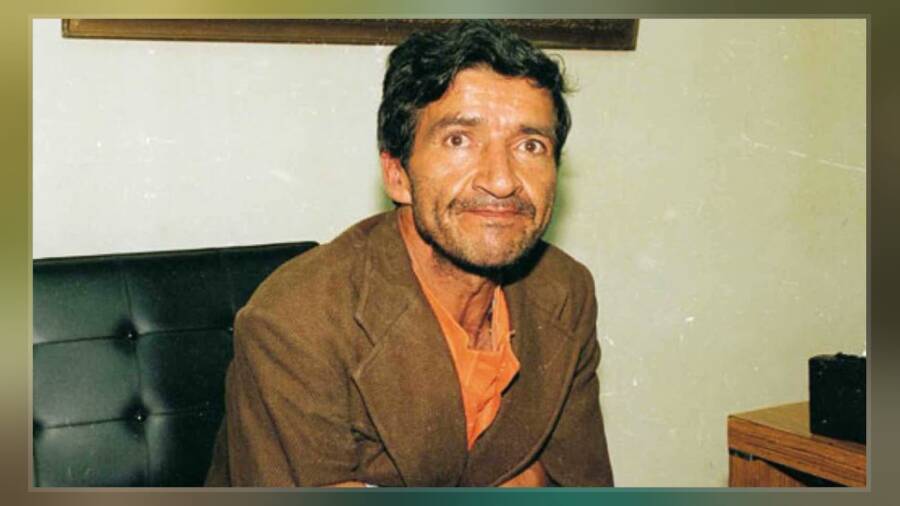From 1969 to 1980, Colombian serial killer Pedro Lopez raped and murdered up to 300 children — and no one knows where he is today.
During the late 1970s, a number of young girls went missing across Peru. At first, the disappearances went largely unnoticed, as many of the girls were street children or members of Indigenous tribes. But one day, a group of Ayachucos people witnessed the near kidnapping of a 9-year-old girl and stopped her would-be abductor, a man named Pedro Lopez.
Rather than turning Lopez over to the police, however, the tribe members beat him, stripped him of his clothes, and started to bury him alive, presumably so that he could die a slow, agonizing death. Lopez likely would have perished, if not for an American missionary who happened upon the scene and convinced the tribespeople to report Lopez to the police.

Hoberman Publishing/Alamy Stock PhotoSerial killer Pedro Lopez, also known as the “Monster of the Andes.”
However, local authorities never took Pedro Lopez into custody. Instead, he was simply expelled from the country — free to abduct more girls off the streets in other South American countries, and free, as it would later be revealed, to brutally rape and murder as many as 300 children.
But even though Lopez was later captured and charged for his crimes in Ecuador in 1980, he was sentenced to just 16 years in prison. Shockingly, he was released early in 1994 for “good behavior” before he was arrested yet again as an illegal immigrant. Then, he was deported back to his home country of Colombia, where he was held in a psychiatric hospital.
Surprisingly, Pedro Lopez was eventually declared sane and was released again in 1998 — and the last time he was ever seen was in 1999.
It wasn’t long before he was suspected of more murders, but to this day, no one has been able to track down the elusive “Monster of the Andes” again.
The Tumultuous Early Life Of Pedro Lopez
Pedro Lopez was born on October 8, 1948 in Santa Isabel, Colombia. His father died about six months before he was born, a member of a right-wing party who was killed during La Violencia, a 10-year civil war between the country’s Conservatives and Liberals that lasted from 1948 to 1958.
According to Britannica, La Violencia claimed more than 200,000 lives. The conflict was especially violent under the reign of Laureano Gómez, a fascist who sought to bring the country under his authoritarian rule, only to collapse under his own power when he was brought down by a military coup.
The conflict continued to have a lasting impact even after the fighting slowed, affecting all areas of society, including the economy.
As all of this was unfolding, Pedro Lopez, the seventh of 13 children, grew up in poverty and chaos. Despite this, Lopez was actually a rather kind and polite child who dreamed of becoming a teacher. He later said, however, that his mother was abusive toward him. He also said that his mother was a sex worker who was frequently abused by her clients.

Colombia PolicePedro Lopez in 1998, upon his release from a psychiatric hospital.
There are varying accounts as to why Lopez left his home as a young child. Some claim that his mother kicked him out at the age of eight after she caught him fondling one of his sisters. Others say that he simply ran away. In any case, Lopez eventually found his way to Colombia’s capital city of Bogotá, where he lived on the streets among other homeless children.
Like many unhoused youths in the area, Lopez joined a gang and got involved with drugs. At one point, Lopez said a seemingly kind stranger offered him a place to stay for the night, and then sexually assaulted him.
When he was 10 years old, Lopez met an elderly couple who offered to give him a home and enrolled him at a school for orphaned children. Unfortunately, Lopez’s chance at a better life was once again destroyed when, at age 12, he was molested by one of the school’s teachers. He promptly ran away from the school and went back to living on the streets.
By this point, Lopez was broken, yet hardened, and he began to speak often of getting revenge for the pain that he had suffered as a child.
Then, in 1969, Pedro Lopez was arrested for auto theft and sentenced to seven years in prison. During his imprisonment, he was once again sexually assaulted, this time by several other inmates. Soon after, Lopez slit his attackers’ throats with a makeshift knife. He was reportedly sentenced to additional time behind bars — about two years — for the killings.
Pedro Lopez’s Brutal Murder Spree Begins
Upon his release from prison in 1978, Pedro Lopez traveled to Peru with a newly acquired taste for blood. He had also developed an intense hatred for his mother — and by proxy, other women — and a distorted objectification of women due to a porn addiction, according to La Vanguardia.
But instead of targeting his mother or other adult women, Lopez decided to start kidnapping and killing young girls in the Ayacucho region of Peru.
Lopez later explained that he started by abducting girls from the nearby Indigenous communities, especially those in the more remote areas. He offered the young children gifts if they came along with him, specifically targeting the ones with “a certain look of innocence.”
After luring a victim away from her loved ones and local community, Lopez explained, “I would take her to a secret hideaway where prepared graves waited… I cuddled them and then raped them at sunrise. At the first sign of light I would get excited. I forced the girl into sex and put my hands around her throat. When the sun rose I would strangle her.”

YouTubePedro Lopez targeted Indigenous girls because he believed white girls were “watched” too closely by their parents.
Lopez delighted in watching “a certain light” go out in his victims’ eyes, but his murderous rituals didn’t end with the young girls’ deaths. He would then violate their dead bodies before hiding or burying the corpses before he went after his next victims. He also noted that he never kidnapped or killed white girls because “their parents were too watchful.”
He would later claim that during this period in Peru, he murdered more than 100 girls between the ages of nine and 12, which would eventually earn him the moniker “Monster of the Andes.” This string of murders only came to a halt because a group of Ayachucos Indigenous people discovered Lopez as he was attempting to lure away a nine-year-old girl from their community.
“Indians in Peru had me tied up and buried in sand to my neck when they found what I had been doing to their daughters,” Lopez recalled of his near-death experience. “They had placed syrup on me and were going to let me be eaten by ants. But an American missionary lady came by in her Jeep and promised them she would turn me over to the police.”
The Ayachucos reluctantly agreed to let the woman take Lopez to the police, dug him up, and returned his belongings to him. But as Lopez and the American woman walked away, some accounts say, she never handed him over to the police. Other accounts say that Lopez was handed over, but managed to escape as he was being sent over to Ecuador.
In either case, Lopez was once again free, and his violent crimes continued.
The Capture And Eventual Release Of The “Monster Of The Andes”
In the late 1970s and 1980, more and more young girls were disappearing as Pedro Lopez had moved on to Colombia and Ecuador. However, without any bodies, most police officers assumed that the disappearances were related to human trafficking or child runaways, not a serial killer.
But, as 9News reported, their opinion changed in 1979, when a flash flood in Ambato, Ecuador revealed the bodies of four young girls.
The discovery was shocking, but when locals reported seeing Lopez leading a 10-year-old girl away just days later, they connected the dots. Police quickly apprehended Lopez, and an undercover investigator posed as his cellmate in order to get a confession. In their cell, Lopez ended up telling his “cellmate” about the brutal rapes and murders he had committed.
Lopez eventually led police to a mass burial site, where he had dumped the bodies of 53 of his victims. A few months later, Lopez claimed to have killed many more, placing the total number, by his count, at more than 300. However, some experts have suggested that Lopez may have been exaggerating and that the number of victims may in fact be closer to 70.

TwitterPedro Lopez has been free since 1998, but his current whereabouts are unknown.
In 1980, Pedro Lopez was ultimately convicted for the murder of 110 people and sentenced to the maximum prison term allowed under Ecuadorian law at the time. Unfortunately, that was only 16 years. Then, he was released two years early, in 1994, for “good behavior,” and deported back to Colombia. There, he was expected to face the firing squad for his crimes committed in that country, but prosecutors were unable to make a case for it.
A judge instead declared that Lopez was insane and ordered that he be placed in a psychiatric hospital. But then, in 1998, the hospital unexpectedly declared him to be sane and released him. Lopez was supposed to report to the police each month after that, but he never did.
Just a few years later, in 2002, Interpol issued a new warrant for his arrest in connection with a new murder case. But the last time Lopez was seen in public was in 1999, when he was renewing his citizenship card in Bogotá.
His whereabouts remain unknown to this day.
After learning about Pedro Lopez, read about some other disturbing serial killers from history. Then, meet the four scariest teenage serial killers.





